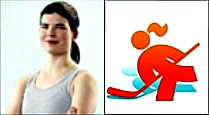Off Season Hockey Workout
 Kim McCullough - Total Female Hockey
Kim McCullough - Total Female HockeyKim McCullough, MSc, YCS
Hockey Workout
1. What should be the goal of a hockey workout program for strength and conditioning in the off-season for a junior or prep player aspiring to play college hockey?
The goal of the off-season program is to ensure that the player prepares themselves for the rigors of the upcoming season. The primary goal is to avoid injury (if you can't play, you can't improve) and of course to increase performance. I always make sure that any injury issues are addressed and managed prior to starting the off-season program. Getting stronger, faster and "fitter" is what most players want - in addition to increasing flexibility and mobility - which is what they really need.
2. What is a common mistake made by players who are training on their own?
A very common mistake made by players training on their own is doing too much too soon. The off-season for most young players is at least 16 weeks long. There is no rush to be in great shape! You want to ensure you are using a hockey workout program that builds a foundation of fitness first and then gets progressively more challenging as the off-season progresses. The other mistake is that young players want to train like the pros! A 14 year old has no business training like a 24 year old. Make sure that you are using a hockey workout program that is age appropriate.
3. How frequent should an athlete be training in the off-season?
Players should train 3 times per week in the beginning of off-season (through June and mid July) and can then ramp it up to 4-6 times per week in July and August. Please note - not every day is going to be a very intense and long hockey workout. 6 times per week would be more geared towards players who have a few years of off-ice training experience and are competing at a very high level.
4. How much time should a hockey player take off at the conclusion of their season before starting the off-season hockey workout program?
Ideally, players should take 2-4 complete weeks off after the season. That means no hockey or off-ice training. They should cross-train and/or play other sports. However, there is so much spring and summer being played these days that players sometimes take no time off. I personally think that the main focus in the off-season should be on training off the ice and playing other sports - but the on-ice piece seems to be a year-long focus now.
5. When should you incorporate on-ice training into the overall off-season plan?
I think players should be on the ice working on individual skills 1-2x per week throughout the summer. Powerskating, stickhandling, shooting, passing should be the focus - not playing more hockey! Maintaining and developing your individual skill throughout the summer will make a huge difference once you step on the ice in the fall.
6. What is your philosophy of training?
My philosophy of training is to prepare athletes for the long-term. I don't believe in quick fix programs that guarantee amazing results in 4 weeks. Players must be able to move well in order to prevent injuries and perform at an elite level. Building a solid foundation is key. Far too many athletes build their strength and speed upon a shaky foundation and inevitably this leads to injury. And if you're hurt, you can't play the game you love.
7. Can you describe the ideal hockey athlete?
Hockey players must be great all-around athletes. They need to be strong, fast, fit, and flexible. They also need to be tough and gritty. Hockey is a game of mistakes so they must be able to read and react quickly and do whatever it takes to make a play. The mental side of the game is even more critical than the physical piece - and as players progress in their career, it is often the distinguishing factor that allows players to succeed.
8. With so many options, what should a player consider with choosing a strength coach?
Do your homework when finding a coach. Ask other athletes (and their parents) who have trained with them what they thought. Get an idea of what the program will include. Make sure you understand how much individual attention you'll be getting - is it 1 coach working with 20 kids or 4 coaches working with 15. Those numbers make a real difference.
9. How should a trainer's methods change when working with a female athlete?
The training methods don't change with female athletes - but the way you coach them may change. Girls tend to want to know "why" more than the boys and are very focused on doing everything perfectly. They want to execute everything cleanly.
For more information about Kim and Total Female Hockey, please contact Kim at
Kim McCullough, MSc, YCS
- Director, Total Female Hockey
- Girls Hockey Director, PEAC School For Elite Athletes
- Phone: (416) 554-0720
- Web: http://www.totalfemalehockeyclub.com
Return from Hockey Workout to Your College Hockey Home
YCH News
- YCH News in October - Conor Doherty
Star Factory Fitness - YCH News in September - NCAA Conference Realignment YCH
- News in August - Junior Hockey Showcase
- YCH News in July - NCAA and the NHL Playoffs
- YCH News in June - NCAA Hockey Coaches
- YCH News In May - NCAA Playoff Hockey Wrap Up
- YCH News in April - Playoff Hockey Recap
- YCH News in March - Playoff Hockey -



